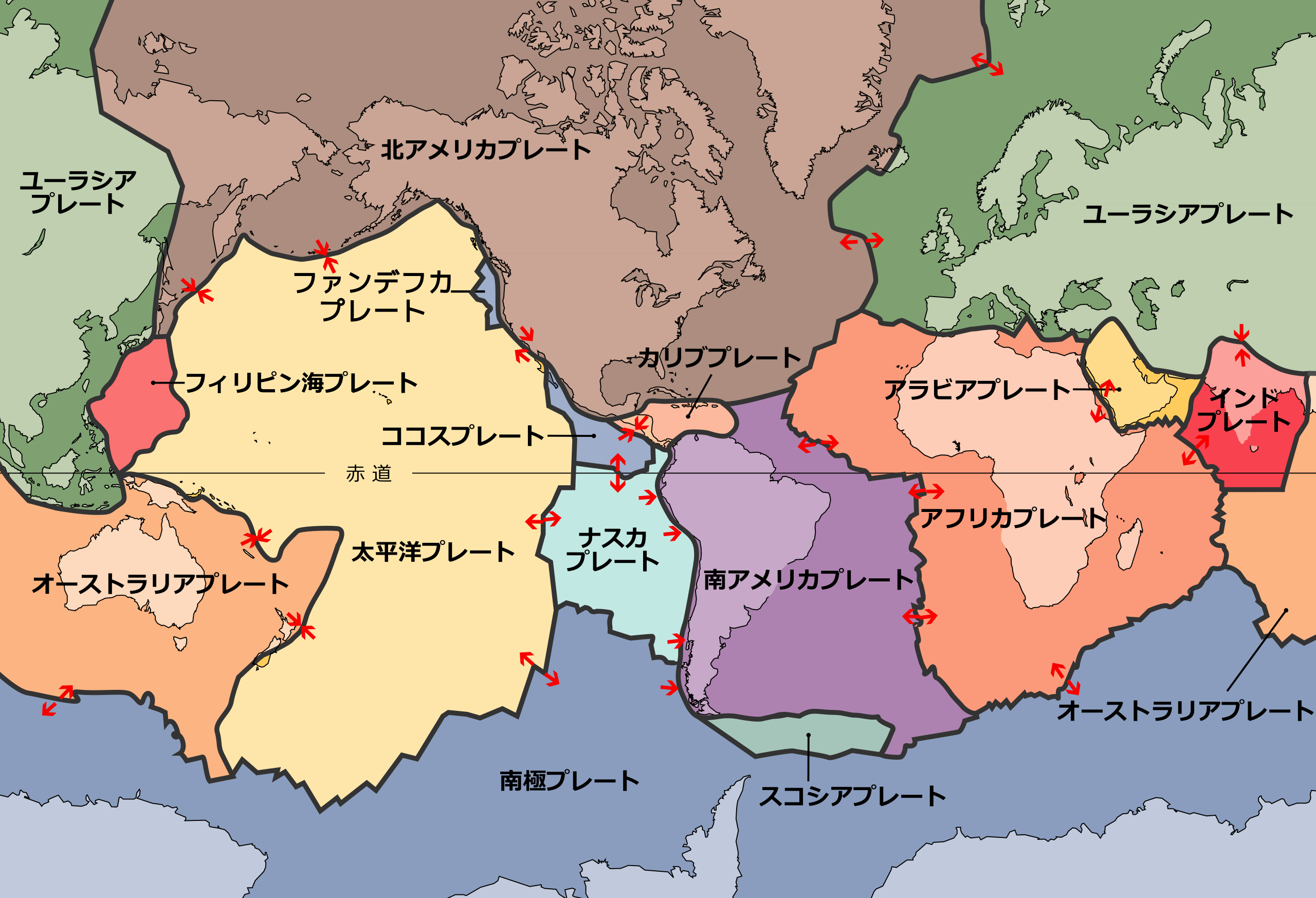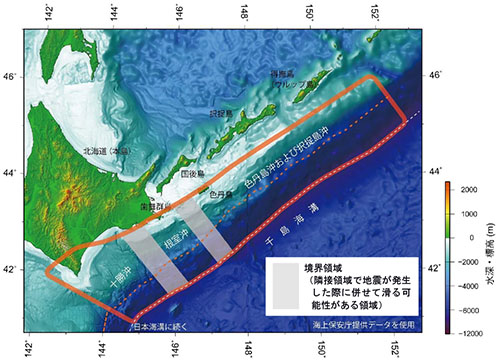キャプティブ 2025.07.30
CA 72 カムチャッカ半島付近での巨大地震の影響
目次
Copyright © Shinichiro Hatani 2025 All rights reserved
For those who prefer to read this column in English, the Japanese text is followed by a British English translation, so please scroll down to the bottom of the Japanese text.
筆者は、今から3年前、2022年5月30日、本コラムに太平洋プレートの北東部分、日本海溝及び千島海溝で発生が懸念されている巨大地震について、「CA 37 日本・千島海溝沿巨大地震に備えるキャプティブ」との一文を投稿した。
その冒頭、以下のように記した。
「キャプティブ」は、「地震リスクに対するリスクマネジメント・ツールとして大きな役割を果たす存在」であるが、地震リスクの規模が大きければ大きいほどその効用は高くなると言える、地震が発生した場合の損害額、被害額が大きくなるからである。また、地震の規模が大きくなると、直接的な被害のみならずインフラが受ける被害も大きくなり、地震から復興しようとする企業にとっては、企業業績回復への足枷になるリスクが高く、「地震リスクへの十分な備え」が必要となるからである。
こうしたことから、キャプティブは南海トラフ巨大地震等、「海溝型地震」に備えようとする企業にとっては、必須の企業戦略、リスクマネジメント・ツールと言われている。
このような「海溝型地震」は、地球規模の「プレート」の境界で発生するという点から巨大な地震になる可能性が高い。「断層型地震」であった1995年の阪神・淡路大震災は、甚大な被害を被ったがマグニチュード(M)は7.3であった。一方、「海溝型地震」であった2011年の東日本大震災のマグニチュード(M)は9.0。地震の規模・エネルギー量の差は300倍以上であった。如何に海溝型地震が巨大地震化するかが解るデータである。
いま、最も危惧されている海溝型地震は、政府中央防災会議が昨年2021年12月21日にその被害想定を発表した「日本海溝・千島海溝沿いの巨大地震 」である。「千島海溝の17世紀型」と言われ、地震規模の想定は「M8.8以上」であり、同報告の中で「Ⅲランク:地震の発生確率が高く30年以内の地震発生率が26%以上」とされている地震である。つまり、北海道西方沖でも、「南海トラフ地震」と同規模の巨大地震が30年以内に26%以上の確率で発生するということである。
「千島海溝の17世紀型」とは、津波堆積物の調査から、太平洋プレートが北米プレートの下に沈み込んでいる千島海溝で17世紀に起きた巨大地震のことを指す。それ以前にも、300~400年の周期で大津波を伴う巨大地震が千島海溝では発生していた。
甚大な被害を引き起す可能性のある「日本・千島海溝巨大地震」、この巨大地震が、30年以内に26%以上の確率で地震が発生するという被害予測を国が出しているのである。
そして、本日2025年7月30日、北アメリカプレートと太平洋プレートが接触、固着している場所、北海道、千島列島、その同じ北アメリカプレート沿い北方、ロシア・カムチャツカ半島で日本時間午前8時24分にマグニチュード(M)8.8の巨大地震が起きた。そして、いま傍らのTVではひっきりなしに全放送局が津波報道を流している。

出典:
上図は 、United States Geological Survey(略称: USGS)、日本では「米国地質調査所」と呼ばれている、米国内務省に属する科学的研究機関が作成した図である。
1.日本海溝・千島海溝巨大地震
本年5月から、北海道の太平洋側ではマグニチュード6クラスの規模の大きい地震が相次いだことを受けて、再度「日本・千島海溝巨大地震」への備えを呼びかけるために、本年2025年6月11日、「CA70 日本海溝・千島海溝地震対策の切り札-キャプティブ 」(https://glc-tokyo.com/news_column/p9374/)と題した一文を投稿した。
一連の北海道沿岸の規模の大きな地震について、気象庁は6月9日に開いた定例会見では、地震の規模がマグニチュード6クラスにとどまっていること、またそれぞれの震源の距離が離れていることから、「それぞれの地震に関連はない」とする見解を示し、今後も規模の大きな地震に注意するよう呼びかけるにとどまったからであり、筆者には、東日本大震災直前の出来事の記憶があったからである。
2.東日本大震災直前の政府 地震調査研究本部 地震調査委員会の報告書
2011年3月9日、政府 地震調査研究本部 地震調査委員会は、「2011年2月の月例報告」を発表した。
その「2.各地方別の地震活動 」「(2)東北地方」の箇所には以下の記述があった。
○ 2月10日に福島県沖の深さ約50kmでマグニチュード(M)5.4の地震が発生した。この地震の発震機構は西北西-東南東方向に圧力軸を持つ逆断層型で、太平洋プレートと陸のプレートの境界で発生した地震である。
○2月27日に福島県沖の深さ約45km で M5.2の地震が発生した。この地震の発 震機構は西北西-東南東方向に圧力軸を持つ逆断層型で、太平洋プレートと陸の プレートの境界で発生した地震である。そして、「2011年2月の地震活動の評価についての補足説明」のページにある「2.各地方別の地震活動」の「(2)東北地方」の箇所には次の記述があった。
三陸沖で2月 13 日から M5.0 以上の地震が4回発生するなどのまとまった地震活動があった。最大の地震は、16日に発生した M5.5であった。発震機構はいずれも西北西-東南東方向に圧力軸を持つ逆断層型で、太平洋プレートと陸のプレートの境界で発生した地震である。
このどこにも、「大震災を予測する」ような言葉は無い。そして、この発表の2日後、3月11日、三陸沖で日本の観測史上最大の地震、マグニチュード(M)9.0の東日本大震災が発生したのである。
最大震度7を観測、大津波を北海道地方、東北地方、関東地方の太平洋沿岸で観測、死者・行方不明者2万人以上の甚大な被害が生じた。「想定外」という言葉がマスコミを賑わした、日本の英知を集めた地震の専門家達でも全く予見できない大震災が発生したのである。

(出典:政府「地震調査研究推進本部」ホームページ)
今回のまとめ
どこの家庭にもある「テーブル」、家族みんなで座って食事をしている時、急に父親がテーブルにドンと手を突いて立ち上がるとテーブル上のモノに何が起きるだろうか。頑丈なテーブルであれば多少の振動が他の家族の方にあるぐらいだが、もしそのテーブルが「柔らかな素材の上に置かれたテーブル」であれば、他の家族の前のテーブルに置かれた食器にかなりの影響が及ぶだろう。
テーブルの片隅に、ある力が加われば、そのエネルギーは同じテーブルの上のあらゆるモノに影響を与える。しかし、なぜか「地球規模のテーブル」である「プレート」、しかもその下には「柔らかいマントルが対流している」にもかかわらず、このことは省みられていないと感じる。
筆者が巨大地震リスクへの対策として早急な「キャプティブの設立」を声高に言い続けている理由の背景はここにある。
甚大な被害を引き起す「日本・千島海溝巨大地震」が、30年以内に26%以上の確率で地震が発生するという被害予測を国が出している。果たして、その「備え」は十分であろうか。柔らかい滞留する溶岩、マントルの上に乗った「同じ地球規模のテーブル」の上に日本は乗っているのである。
マグニチュードが1つ大きくなると地震のエネルギーは約30倍、マグニチュードが2つ違うと地震のエネルギーは約1,000倍(≒30×30倍)、マグニチュードが3つ大きくなると地震のエネルギーは約30,000倍(≒30×30×30倍)になる。
マグニチュード0.1の差はエネルギーでは約1.4倍の差、マグニチュード0.2の差では約2倍、「日本・千島海溝巨大地震」の規模は東日本大震災を超える規模の超巨大地震、東日本大震災がマグニチュード9.0であり、想定している最大規模の「千島海溝モデル」ではマグニチュード9.3、つまり「日本・千島海溝巨大地震」(千島海溝モデル)の地震のエネルギー量は、この計算式から未曾有の被害をもたらした「東日本大震災」の約2.8倍のエネルギー量になる。如何に巨大な地震であるかが解る。
冒頭の通り、当然その被害も甚大になるため、地震保険の備えとしては、「できるだけ支払限度額を高くした地震保険を準備する必要」がある。そのためには、「日本では十分な地震保険キャパシティ(引受力)の確保が困難」であるため、キャプティブの力を借りる必要がある。キャプティブを設立して海外の再保険会社からできるだけ多くの再保険サポートを得るようにするのである。
甚大な被害を引き起す可能性のある「日本・千島海溝巨大地震」、この巨大地震が、30年以内に26%以上の確率で地震が発生するという被害予測を国が出しているのである。果たして、その「備え」は十分であろうか。
執筆・翻訳者:羽谷 信一郎
English Translation
Captive (CA)72 Impact of the massive earthquake near the Kamchatka Peninsula
The author, three years ago on 30 May 2022, posted an article in this column titled ‘CA 37: Preparing for a Major Earthquake Along the Japan-Kuril Trench Using Captive Insurance,’ discussing the potential for a massive earthquake in the northeastern part of the Pacific Plate, along the Japan Trench and the Kuril Trench.
At the beginning of that article, the author wrote the following:
‘Captives’ play a significant role as risk management tools for earthquake risks. The larger the scale of the earthquake risk, the greater the utility of captives, as the potential damage and losses from an earthquake increase accordingly.Additionally, as the scale of an earthquake increases, not only direct damage but also damage to infrastructure becomes more severe, posing a high risk of hindering a company’s efforts to recover its business performance after an earthquake. Therefore, ‘adequate preparation for earthquake risks’ is essential.
For these reasons, a captive is considered an essential corporate strategy and risk management tool for companies seeking to prepare for ‘trench-type earthquakes’ such as the Nankai Trough massive earthquake.
Such ‘trench-type earthquakes’ have a high probability of becoming massive earthquakes because they occur at the boundaries of “plates” on a global scale. The 1995 Great Hanshin-Awaji Earthquake, which was a ‘fault-type earthquake,’ caused severe damage despite having a magnitude (M) of 7.3. On the other hand, the 2011 Great East Japan Earthquake, which was a ‘trench-type earthquake,’ had a magnitude (M) of 9.0.The difference in scale and energy between the two earthquakes was more than 300 times. This data clearly demonstrates how trench-type earthquakes can become massive earthquakes.
The most feared trench-type earthquake at present is the ‘Japan Trench and Kuril Trench Mega-Earthquake’ whose damage estimates were announced by the Central Disaster Prevention Council on 21 December 2021. Known as the ‘17th-century-type Kuril Trench earthquake,’ it is estimated to have a magnitude of ‘M8.8 or higher,’ and the report classifies it as ‘Rank III: High probability of occurrence, with a 26% or higher probability of occurrence within 30 years.’ This means that in the waters west of Hokkaido, there is a 26% or higher probability of a massive earthquake of the same scale as the ‘Nankai Trough earthquake’ occurring within the next 30 years.
The ‘17th-century-type Kuril Trench earthquake’ refers to a massive earthquake that occurred in the Kuril Trench in the 17th century, where the Pacific Plate subducts beneath the North American Plate, as indicated by tsunami deposit surveys. Prior to that, massive earthquakes accompanied by large tsunamis had occurred in the Kuril Trench at intervals of approximately 300 to 400 years.
The ‘Japan-Kuril Trench Mega-Earthquake,’ which has the potential to cause severe damage, is predicted by the government to have a 26% or higher probability of occurring within the next 30 years.
On 30 July 2025, at 8:24 a.m. Japan Standard Time, a massive earthquake with a magnitude (M) of 8.8 occurred at the point where the North American Plate and the Pacific Plate meet and are locked together, in Hokkaido, the Kuril Islands, and along the same North American Plate to the north, near the Kamchatka Peninsula in Russia.
1. Japan Trench-Kuril Trench Massive Earthquake
In response to the series of large earthquakes with magnitudes of 6 or higher that occurred along the Pacific coast of Hokkaido starting in May of this year, on 11 June 2025,
‘CA70 Japan Trench-Kuril Trench Earthquake Countermeasures: The Ace in the Hole – Captive’ (https://glc-tokyo.com/news_column/p9374/).
Regarding the series of large earthquakes along the coast of Hokkaido, the Japan Meteorological Agency stated at its regular press conference on 9 June that the earthquakes were limited to magnitude 6 and that the epicentres were distant from each other, concluding that ‘there is no connection between the earthquakes.’ The agency urged continued vigilance for large earthquakes, but the author, recalling the events preceding the Great East Japan Earthquake, felt compelled to take action.
2. Report of the Earthquake Research Committee of the Earthquake Research Headquarters of the Government prior to the Great East Japan Earthquake
On 9 March 2011, the Earthquake Research Committee of the Earthquake Research Headquarters of the Government released its ‘Monthly Report for February 2011.’
The following description was included in the section ‘2. Earthquake Activity in Each Region’ and ‘(2) Tohoku Region.’
• On 10 February, an earthquake with a magnitude (M) of 5.4 occurred off the coast of Fukushima Prefecture at a depth of approximately 50 km. The focal mechanism of this earthquake was a reverse fault type with a pressure axis oriented in a northwest-southeast direction, occurring at the boundary between the Pacific Plate and the continental plate.
• On February 27, an earthquake with a magnitude (M) of 5.2 occurred at a depth of approximately 45 km off the coast of Fukushima Prefecture. The focal mechanism of this earthquake was a reverse fault type with a pressure axis oriented in a northwest-southeast direction, and it occurred at the boundary between the Pacific Plate and the continental plate.
Additionally, the following description was included in the section titled ‘(2) Earthquake Activity by Region’ under ‘2. Earthquake Activity by Region’ in the page titled ‘Supplementary Explanation on the Evaluation of Earthquake Activity in February 2011’:
There was a series of earthquakes, including four earthquakes of magnitude 5.0 or greater, off the Sanriku coast from February 13. The largest earthquake was a magnitude 5.5 earthquake that occurred on the 16th.The focal mechanisms were all reverse faults with a pressure axis oriented northwest-southeast, and the earthquakes occurred at the boundary between the Pacific Plate and the continental plate.
There is no mention of ‘predicting a major earthquake’ anywhere in this report. Two days after this announcement, on 11 March, the Great East Japan Earthquake, the largest earthquake ever recorded in Japan with a magnitude (M) of 9.0, occurred off the Sanriku coast.
The earthquake reached a maximum intensity of 7, and massive tsunamis were observed along the Pacific coast of Hokkaido, Tohoku, and Kanto regions, resulting in over 20,000 deaths and missing persons. The term ‘unforeseeable’ dominated the media, as even Japan’s leading earthquake experts, who had pooled their collective wisdom, were unable to predict this devastating earthquake.
Summary of this issue
In every household, there is a table where the family sits down to eat together. What would happen if the father suddenly stood up and slammed his hand on the table? If the table is sturdy, there would only be a slight vibration felt by the other family members. However, if the table is made of soft material, the dishes on the table in front of the other family members would be significantly affected.
If a force is applied to one corner of a table, that energy affects everything on the same table. However, for some reason, this phenomenon is not considered when it comes to the ‘global table’ known as the ‘plate,’ especially since there is a ‘soft mantle’ beneath it that is constantly convecting.
This is the background behind the author’s repeated calls for the urgent establishment of a ‘captive’ as a measure against the risk of a massive earthquake.
The government has predicted that there is a 26% or higher probability of a massive earthquake occurring within the next 30 years, which could cause catastrophic damage. Is the current level of preparedness sufficient? Japan sits on top of soft, stagnant lava, on a ‘global table’ that rests on the mantle.
An increase of one magnitude in an earthquake’s magnitude results in approximately 30 times more energy, an increase of two magnitudes results in approximately 1,000 times more energy (approximately 30 × 30 times), and an increase of three magnitudes results in approximately 30,000 times more energy (approximately 30 × 30 × 30 times).
A difference of 0.1 in magnitude results in approximately 1.4 times the energy, while a difference of 0.2 in magnitude results in approximately 2 times the energy (101.5 × 0.2 = 100.3 ≒ 1.995).The scale of the ‘Japan-Kuril Trench Mega-Earthquake’ is an ultra-large earthquake exceeding the scale of the Great East Japan Earthquake. The Great East Japan Earthquake had a magnitude of 9.0, and the maximum scale assumed in the ‘Kuril Trench Model’ is magnitude 9.3. Therefore, the energy of the ‘Japan-Kuril Trench Mega-Earthquake’ (Kuril Trench Model) is approximately 2.8 times the energy of the Great East Japan Earthquake, which caused unprecedented damage, according to this calculation.This illustrates just how massive the earthquake would be.
As mentioned at the beginning, the damage would naturally be immense, so it is necessary to prepare earthquake insurance with as high a payment limit as possible. However, since it is difficult to secure sufficient earthquake insurance capacity (underwriting capacity) in Japan, it is necessary to leverage the power of captives. This involves establishing a captive and securing as much reinsurance support as possible from overseas reinsurance companies.
The government has predicted that there is a 26% probability of a massive earthquake occurring in the Japan-Kuril Trench within the next 30 years, which could cause enormous damage. Are we sufficiently prepared for such an event?
Author/translator: Shinichiro Hatani

